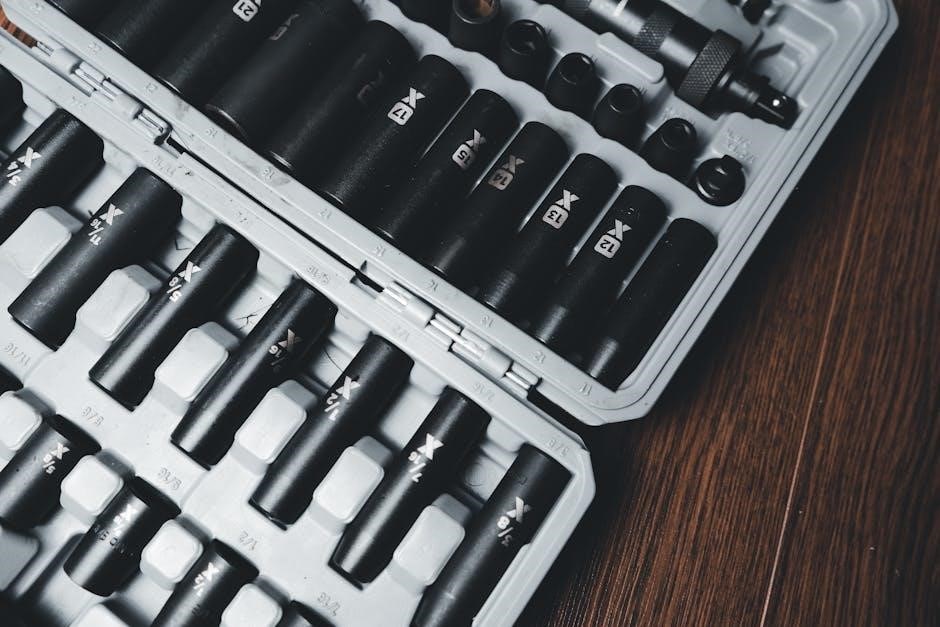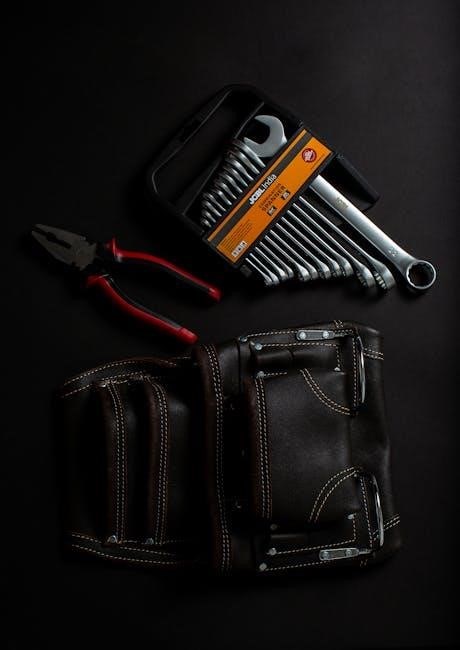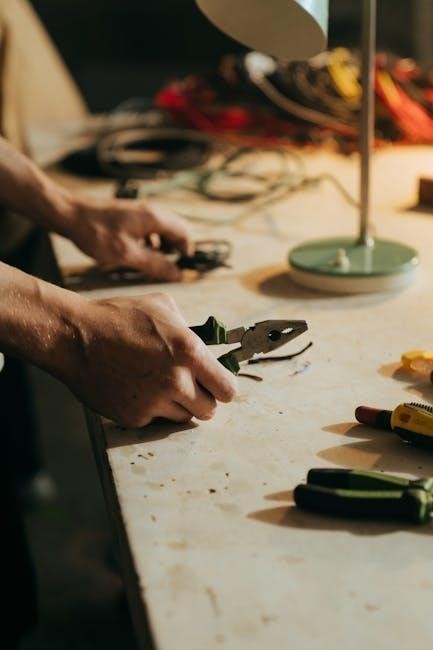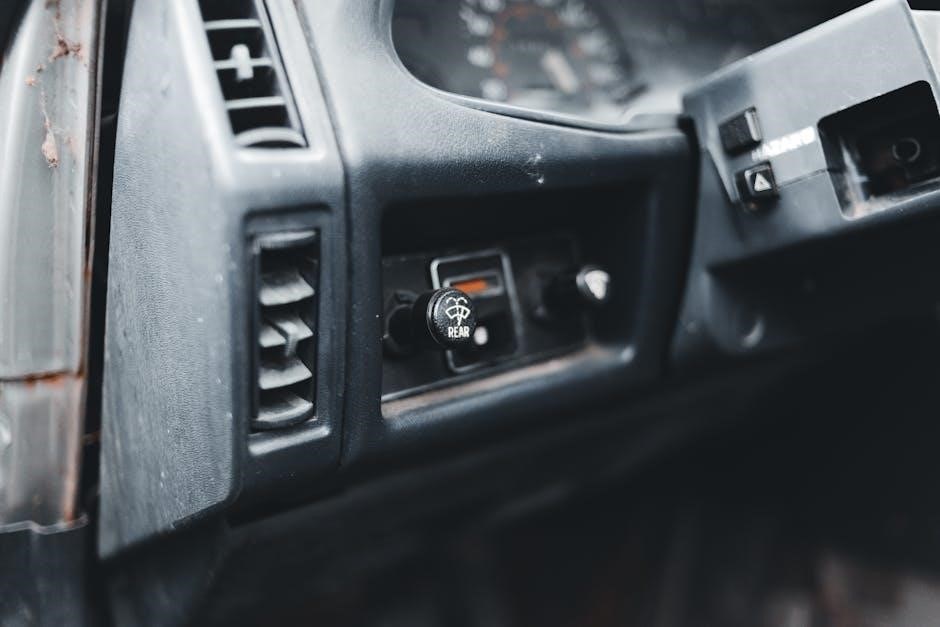A torque wrench is a precision tool designed to apply a specific amount of force, ensuring proper tightening or loosening of bolts and nuts. Essential for maintaining accuracy, it prevents damage to materials and enhances safety in mechanical tasks. Available in manual, electronic, and pneumatic models, torque wrenches are indispensable in engineering, automotive, and industrial applications, offering reliability and consistency in achieving precise torque values.

1.1 What is a Torque Wrench?

A torque wrench is a specialized tool designed to apply a precise amount of rotational force, measured in units of torque, to bolts, nuts, or other fasteners. It ensures that the correct tension is achieved without over-tightening or under-tightening, which can lead to damage or failure. Available in various types, including manual, electronic, and pneumatic models, torque wrenches are essential for tasks requiring accuracy and control. They are widely used in automotive repair, construction, and industrial settings, where proper fastening is critical for safety and performance. By providing a controlled and measurable force, torque wrenches help maintain the integrity of mechanical systems and prevent potential hazards.
1.2 Importance of Using a Torque Wrench
Using a torque wrench is crucial for ensuring the integrity and safety of mechanical systems. Proper torque application prevents over-tightening, which can damage threads or strip bolts, and under-tightening, leading to loose connections. In automotive and industrial settings, incorrect torque can result in equipment failure, posing safety risks. Torque wrenches also extend the lifespan of components by distributing stress evenly, reducing wear and tear. Additionally, they are essential for adhering to manufacturer specifications, ensuring compliance with quality and safety standards. By providing precise control, torque wrenches minimize the risk of costly repairs and enhance overall system reliability, making them an indispensable tool in any workshop or maintenance environment.

Understanding Torque
Torque is a rotational force causing objects to turn or twist. It depends on the force applied and the distance from the axis of rotation, essential for precise mechanical operations.
2.1 Definition and Formula of Torque
Torque, also known as the moment of force, is a measure of the rotational force that causes an object to turn or twist. It is defined as the product of the force applied and the perpendicular distance from the axis of rotation to the line of action of the force. The formula for torque (τ) is:
τ = r × F
where r is the distance from the axis of rotation, and F is the applied force. Torque is essential in understanding rotational motion, similar to how force is fundamental in linear motion. It is measured in Newton-meters (Nm) and plays a critical role in engineering and physics applications. Accurate calculation of torque ensures proper mechanical operations and prevents damage to materials.

2.2 Units of Torque
Torque is measured in units that represent the product of force and distance. The most common unit is the Newton-meter (Nm), which is widely used in engineering and physics. In the United States, torque is often expressed in foot-pounds (ft-lb), where one foot-pound equals approximately 1.3556 Newton-meters. Other units include kilogram-force meters (kgf·m) and pound-force inches (lbf·in), with the latter commonly used in automotive applications. Understanding the correct unit is crucial for accurate torque application, as using the wrong unit can lead to improper tightening or loosening of fasteners. Standardization of units ensures consistency and safety in mechanical operations. Always refer to the manufacturer’s specifications for the appropriate unit of measurement.

Types of Torque Wrenches
Torque wrenches are available in manual, electronic, and pneumatic models, each designed for specific applications. Manual wrenches are simple and cost-effective, while electronic and pneumatic versions offer precision and efficiency in industrial settings.
3.1 Manual Torque Wrenches
A manual torque wrench is a basic yet essential tool for applying precise torque to bolts and nuts. It operates via a mechanical system, where the user applies force to a handle, and the wrench slips or clicks when the set torque is reached. These wrenches are cost-effective, easy to use, and ideal for applications where electronic or pneumatic tools are unnecessary. They are commonly used in automotive repair, construction, and DIY projects. Manual torque wrenches are durable, require minimal maintenance, and provide a straightforward solution for torque control. Their simplicity makes them a favorite among professionals and hobbyists alike, ensuring accurate and reliable results in various mechanical tasks.
3.2 Electronic Torque Wrenches
Electronic torque wrenches are advanced tools that utilize digital technology to measure and apply precise torque values. Equipped with LCD screens, they provide real-time torque readings and alerts when the desired torque is reached. These wrenches often feature adjustable units, memory storage for multiple torque settings, and data export capabilities. They are highly accurate and ideal for industries requiring strict torque control, such as aerospace, automotive manufacturing, and precision engineering. Electronic torque wrenches reduce human error and increase efficiency, making them a valuable asset in professional settings. Their advanced features ensure consistency and reliability, while their user-friendly interfaces simplify complex torque applications.
3.3 Pneumatic Torque Wrenches
Pneumatic torque wrenches are high-performance tools powered by compressed air, designed for heavy-duty applications. They deliver consistent and precise torque, making them ideal for industrial and construction tasks. These wrenches are capable of generating high torque outputs with minimal effort, reducing operator fatigue. Pneumatic models are often used in repetitive or large-scale operations, such as in manufacturing plants or shipyards. They feature adjustable torque settings and ergonomic designs for improved control. Their durability and reliability make them a preferred choice for demanding environments. Regular maintenance, such as cleaning and lubricating the air motor, ensures optimal performance. Pneumatic torque wrenches are versatile, efficient, and cost-effective solutions for achieving accurate torque in challenging applications.
Safety Precautions
Always wear protective gear, including gloves and safety glasses, when using a torque wrench. Ensure proper handling and storage to prevent accidents and tool damage. Follow workplace guidelines to maintain a safe environment and avoid injuries. Regular inspections of the wrench are crucial for identifying wear and tear. Proper training is essential to operate the tool effectively and safely. Adhering to these precautions minimizes risks and ensures reliable performance. A clean and organized workspace further enhances safety, reducing the likelihood of mishaps. By prioritizing safety, users can achieve accurate torque applications while protecting themselves and their equipment. Consistent adherence to safety protocols is vital for long-term tool durability and operational success.
4.1 Handling and Storage Tips
Proper handling and storage of a torque wrench are crucial to maintain its accuracy and longevity. Always handle the tool with clean, dry hands to prevent slipping and damage. Avoid dropping the wrench, as this can alter its calibration. Store the torque wrench in a protective case or pouch to shield it from dust and moisture. Keep it in a dry, cool place away from direct sunlight. Regularly inspect the wrench for signs of wear or damage, such as loose parts or rust. Clean the tool with a soft cloth after use to remove dirt or grease. Never store the wrench in extreme temperatures or humid environments, as this can affect its performance. Proper storage ensures the wrench remains reliable for future use.
4.2 Workplace Safety Guidelines
Ensuring workplace safety when using a torque wrench is essential to prevent accidents and injuries. Always wear protective gear, such as gloves and safety glasses, to safeguard against flying debris or tool slippage. Ensure the work area is clear of obstacles and tripping hazards. Use the correct torque wrench size and type for the task to avoid overexertion or loss of control. Follow proper tightening sequences to prevent damage to equipment or bolts. Keep loose clothing and long hair tied back to avoid entanglement with tools. Regularly inspect the wrench for damage or wear, and replace it if necessary. Adhere to industry standards and manufacturer guidelines for torque applications. Proper training and awareness are key to maintaining a safe working environment. By following these guidelines, you can minimize risks and ensure safe, efficient operations.

Choosing the Right Torque Wrench
Selecting the appropriate torque wrench involves considering factors like drive size, torque range, and application type. Ensure the wrench matches the bolt size and material to achieve precise control and avoid damage. Proper selection enhances efficiency and safety in various mechanical tasks, making it a crucial step for optimal performance and reliability in engineering and automotive applications.
5.1 Factors to Consider
When selecting a torque wrench, several factors must be considered to ensure optimal performance. First, the drive size should match the bolts or nuts being tightened to prevent slippage and damage. The torque range is another critical factor, as it must align with the specifications of the task at hand. Additionally, the type of application—whether it’s for automotive, industrial, or precision engineering—plays a significant role. The material of the wrench, such as steel or aluminum, affects durability and weight. Ergonomics and comfort are also important, especially for prolonged use. Finally, the accuracy and certification of the wrench, often indicated by ISO standards, ensure reliability and consistency in torque application. By carefully evaluating these factors, users can choose a torque wrench that meets their specific needs and delivers precise results.
5.2 Drive Size and Torque Range
Drive size and torque range are essential considerations when selecting a torque wrench. The drive size must match the bolt or nut head to ensure proper fitment and prevent slippage, which can damage the fastener or surrounding material. The torque range should align with the specific requirements of the task, as applying too little or too much torque can lead to under-tightening or over-tightening, potentially causing damage or safety hazards. It’s crucial to choose a wrench with a torque range that covers the desired values for accuracy and reliability. Always refer to the manufacturer’s specifications to ensure compatibility and optimal performance for the intended application.
Operating Instructions
Always follow guidelines for safe and precise torque application, ensuring proper handling and adherence to manufacturer recommendations to avoid errors and potential damage during operation.
6.1 Preparing the Torque Wrench
Before using a torque wrench, ensure it is properly prepared. Inspect the tool for any damage or wear, such as a bent handle or damaged head. Calibrate the wrench according to the manufacturer’s instructions to maintain accuracy. Set the desired torque value using the adjustment mechanism, ensuring it aligns with the specifications of your task. Always use the correct drive size and socket for the bolt or nut to avoid slippage. Store the wrench in a dry, secure location when not in use to prevent damage. Regularly check and maintain the wrench to ensure optimal performance and reliability in various applications, from automotive repairs to industrial tasks.
6.2 Setting the Torque Value
Setting the correct torque value is crucial for ensuring accuracy and safety. Always refer to the manufacturer’s specifications or a torque chart to determine the appropriate value for your task. For manual wrenches, adjust the torque by turning the handle or dial until the desired value is reached. Electronic wrenches typically require inputting the value via a digital interface. Ensure the wrench is set to the correct unit of measurement, such as foot-pounds or Newton-meters. Double-check the setting before applying force to avoid over- or under-tightening, which can lead to damage or safety hazards. Properly calibrated and set torque wrenches are essential for achieving precise results in mechanical tasks.
6.3 Using the Torque Wrench
Using a torque wrench requires precision and care to ensure accurate results. Begin by attaching the appropriate socket to the wrench, matching the bolt or nut size. Position the wrench correctly on the bolt head, ensuring a firm grip. For manual wrenches, apply steady, consistent force until the internal mechanism signals the torque is reached, often with a click or slip. For electronic models, hold the wrench firmly and wait for the LED light or beep to confirm the torque value. Avoid using cheater bars or excessive force, as this can damage the wrench or the bolt. Always follow the manufacturer’s guidelines for proper usage and safety. Proper technique ensures reliability and prevents potential damage to components.
Maintenance and Calibration
Regular maintenance ensures torque wrench accuracy and longevity. Clean and lubricate moving parts, store properly, and recalibrate periodically. Calibration involves adjusting to manufacturer specifications for precise measurements.
7.1 Regular Maintenance Tips
Regular maintenance is crucial for ensuring the accuracy and longevity of a torque wrench. Start by cleaning the tool thoroughly, removing any dirt or debris that may interfere with its operation. Store the wrench in a dry, secure location to prevent rust or damage. Lubricate moving parts periodically to maintain smooth functionality. Inspect the wrench for wear and tear, replacing any damaged components promptly. Additionally, check the calibration regularly and recalibrate as needed to ensure precise torque measurements. Following the manufacturer’s maintenance schedule is essential for optimal performance and reliability. Proper care extends the tool’s lifespan and guarantees consistent, accurate results in various applications.
7.2 Calibration Process

The calibration process ensures a torque wrench delivers accurate measurements. Begin by gathering necessary tools, such as a torque standard or calibration equipment. Set the wrench to its lowest torque setting and attach it to the calibration device. Apply gradual force while monitoring the gauge to verify the wrench reaches the specified torque. Record the readings and adjust the wrench according to the manufacturer’s instructions if deviations are noted. Repeat the process for all torque settings to ensure consistency. After calibration, store the wrench properly to maintain its accuracy. Regular recalibration is recommended, especially after heavy use or if the wrench has been dropped, to uphold precision and reliability in future applications.

Troubleshooting Common Issues

Identify and resolve issues like inaccurate torque readings, slipping handles, or worn components. Regular maintenance and proper storage can prevent these problems, ensuring optimal tool performance and longevity.
8.1 Identifying Common Problems
Common issues with torque wrenches include inaccurate torque readings, slipping handles, and worn or damaged components. Inaccurate readings often result from improper calibration or misuse. Slipping handles can occur due to wear and tear, reducing grip and control. Worn components, such as the gear mechanism or ratchet, may lead to inconsistent performance. Additionally, electronic torque wrenches may experience battery drain or digital display malfunctions. Identifying these problems early is crucial to maintaining tool accuracy and ensuring safe operation. Regular inspection and maintenance can help prevent these issues, while addressing them promptly can extend the tool’s lifespan and reliability.
8.2 Solutions and Repair Tips
To address common torque wrench issues, start with calibration. Recalibrate the tool according to the manufacturer’s instructions to restore accuracy. For slipping handles, inspect and tighten or replace worn grips. If components like gears or ratchets are damaged, replace them with genuine parts. For electronic models, check battery connections or recalibrate digitally. Regularly lubricate moving parts to ensure smooth operation. Store the wrench in a dry, secure location to prevent damage. If problems persist, consult a professional or contact the manufacturer. Proper maintenance and timely repairs can extend the tool’s lifespan and ensure reliable performance. Always follow safety guidelines to avoid accidents during repair.
Conclusion
A torque wrench is an essential tool for precise bolting, ensuring safety and preventing damage. Proper use, maintenance, and calibration are crucial for optimal performance and longevity. Always follow guidelines to achieve accurate results and extend the tool’s lifespan, ensuring reliability in every application.
9.1 Summary of Key Points
Torque wrenches are essential tools for applying precise force, ensuring safety and preventing damage. They are available in manual, electronic, and pneumatic models, each suited for specific tasks. Proper use involves setting the correct torque value, maintaining the tool, and following safety guidelines. Understanding torque, its formula, and units is crucial for effective application. Regular calibration and maintenance ensure accuracy and longevity. Always store the wrench correctly and follow workplace safety protocols. By adhering to these principles, users can achieve reliable results and extend the tool’s lifespan. Torque wrenches are indispensable in engineering, automotive, and industrial settings, making them a vital component in any toolkit.
9.2 Final Tips for Effective Use
To maximize the effectiveness of a torque wrench, always calibrate it regularly and store it properly. Use the correct drive size and ensure the wrench is set to the precise torque value required for the task. Avoid over-tightening, as this can damage materials or strip threads. Keep the tool clean and well-maintained to ensure accuracy. Follow the manufacturer’s guidelines for operation and maintenance. Always double-check the torque value before applying force, and use the appropriate socket or adapter for the job. By adhering to these tips, users can ensure safe, precise, and efficient results in their work. Proper care and use will extend the lifespan of the torque wrench and enhance overall performance.






























